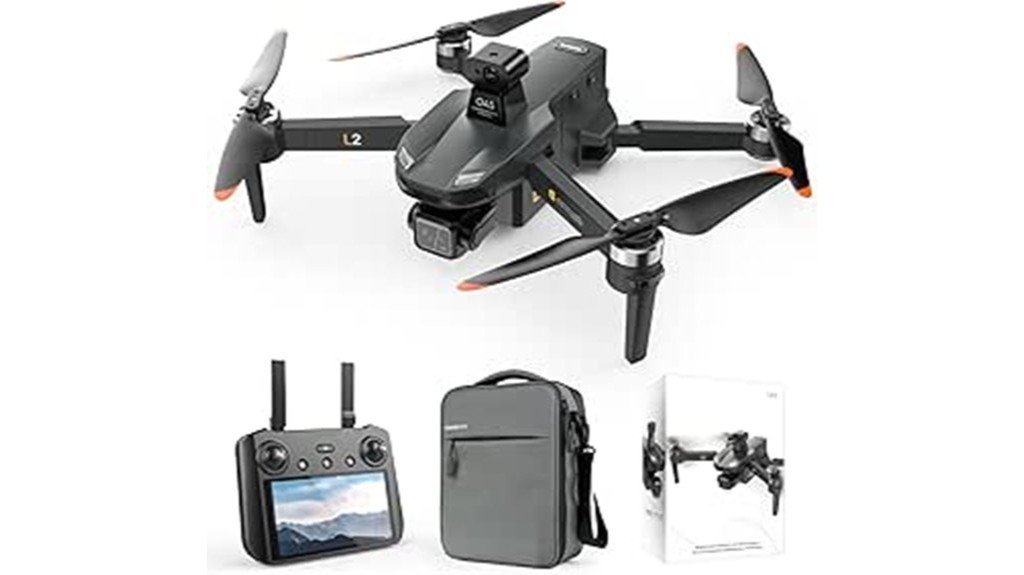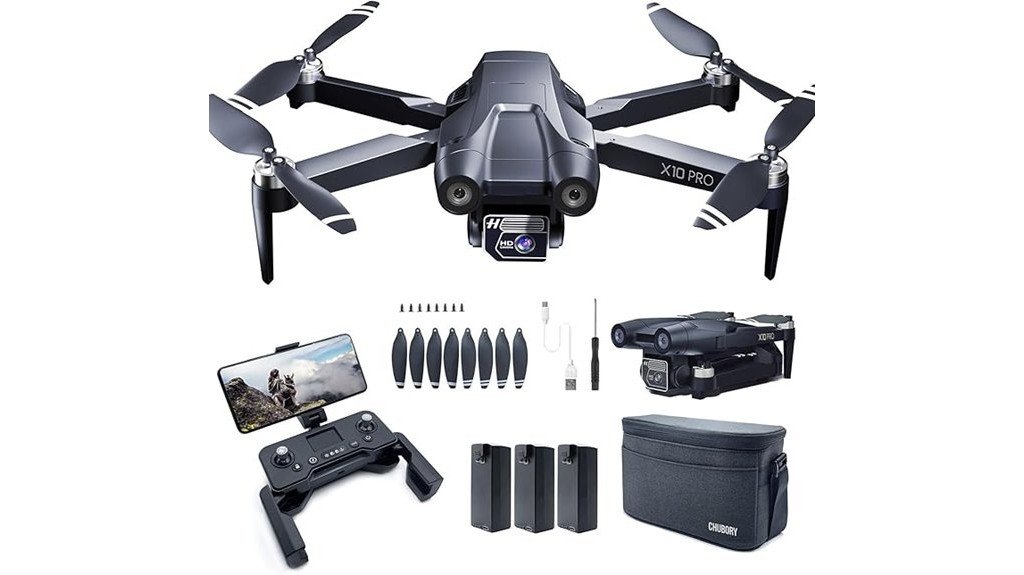Flying a drone in strong winds can feel like trying to balance a tightrope act on a windy day—one misstep and you’re in trouble. The right drone can make all the difference, ensuring your aerial shots are smooth and stable despite the gusts. So, what are the best options out there for windy conditions? Let’s explore three top contenders that promise not only functionality but also peace of mind when the weather turns blustery.
Upgraded Pro Drone with Camera for Adults

If you’re an adult looking for a drone that can handle windy conditions, the Upgraded Pro Drone with Camera is an excellent choice. With its 4K UHD photo and video capture, you’ll capture stunning visuals even in challenging weather. The drone boasts a long-range capability of up to 5 miles and a remarkable 84 minutes of flight time with dual batteries. Equipped with 360° obstacle avoidance and GPS features, it guarantees safe navigation. Plus, you can enjoy versatile shooting angles with 50x digital zoom. Overall, it’s reliable, user-friendly, and perfect for both hobbyists and casual users.
Best For: The Upgraded Pro Drone with Camera is best for adults seeking a reliable and user-friendly drone for capturing high-quality visuals in various conditions.
Pros:
- Exceptional 4K UHD photo and video quality for stunning visuals.
- Impressive flight time of 84 minutes with dual batteries, allowing for extended use.
- 360° obstacle avoidance technology enhances safety during flights.
Cons:
- Requires outdoor calibration prior to flight, which may be inconvenient for some users.
- Some users have suggested improvements for the accompanying app.
- The drone’s weight of 1.29 pounds may limit portability for travel.
X1 PROMAX 8K Action Flying Camera Drone

The X1 PROMAX 8K Action Flying Camera Drone is a game changer for adventurers and content creators looking to capture stunning footage in challenging, windy conditions. With its world-first 8K@30fps capabilities and 4K vertical video options, you’ll achieve cinematic-quality shots. Its innovative OmniTerrain allows for all-terrain flight, while over 10 automatic flight modes cater to diverse filming needs. The foldable design enhances portability, fitting easily into your backpack. Enjoy hands-free operation and smart controls via the app, ensuring a user-friendly experience. While battery life may be a concern, the impressive video quality and customer service make it worth considering.
Best For: Adventurers and content creators seeking high-quality aerial footage in diverse and challenging environments.
Pros:
- World’s first 8K@30fps video capability delivers stunning, cinematic-quality footage.
- Innovative OmniTerrain feature allows for all-terrain flight, making it suitable for various outdoor activities.
- Hands-free operation and app control enhance user experience and ease of use.
Cons:
- Short battery life of 10-13 minutes may limit extended filming sessions.
- Loss of tracking can occur in complex environments, affecting filming reliability.
- Potential video stabilization issues may arise, impacting the overall video quality.
CHUBORY X10 PRO 5G FPV RC Quadcopter with Camera

Designed for both beginners and experienced pilots, the CHUBORY X10 PRO 5G FPV RC Quadcopter excels in windy conditions thanks to its wind-resistant alloy brushless motors. Weighing under 0.55 lbs, it’s FAA-exempt and easy to handle. With a stunning 4K UHD camera and a 90-minute flight time powered by a triple-battery system, you can capture breathtaking aerial shots. The drone’s GPS-enabled features, like Follow Me and Auto Return Home, enhance your flying experience. Plus, its foldable design and durable carrying case make it perfect for outdoor adventures. Enjoy smooth, whisper-quiet operation with powerful thrust in any weather.
Best For: The CHUBORY X10 PRO 5G FPV RC Quadcopter is best for both beginners and experienced pilots looking for a high-quality, user-friendly drone for capturing stunning aerial footage.
Pros:
- Excellent 90-minute flight time with a triple-battery system for extended aerial adventures.
- Equipped with a high-resolution 4K UHD camera and adjustable wide-angle lens for professional-grade imaging.
- GPS-enabled intelligent flight modes enhance ease of use, making it suitable for various skill levels.
Cons:
- Control range of 3280 ft may be limited for advanced users seeking longer distances.
- The drone’s lightweight design may be less stable in extremely windy conditions despite wind-resistant motors.
- Requires some setup and familiarization for beginners to fully utilize all features effectively.
Factors to Consider When Choosing a Drone for Windy Conditions
When you’re selecting a drone for windy conditions, several factors can make a big difference. You’ll want to take into account weight and stability, as well as wind resistance features, to guarantee your drone can handle the breeze. Don’t forget about flight time, camera quality, and control range, since these elements also play an essential role in your flying experience.
Weight and Stability
Weight is a key factor in determining how well a drone performs in windy conditions. Heavier drones generally provide more stability, making them less prone to being tossed around by gusts. If you opt for a lighter drone, you might face challenges maintaining stable flight in high winds, which can negatively impact control and image quality. Additionally, the drone’s design—like its aerodynamic shape and rotor placement—affects its performance in breezy environments. Choosing a drone equipped with GPS and altitude hold functions can also enhance stability, as it helps maintain position against the wind. So, when selecting your drone, prioritize weight and design to guarantee reliable performance in challenging weather conditions.
Wind Resistance Features
To guarantee your drone can handle windy conditions, consider its wind resistance features. Look for drones equipped with wind-resistant alloy brushless motors; these can maintain performance and stability even when gusts hit. A lightweight design is essential too, as heavier drones may struggle with lift and stability in strong winds. GPS-enabled drones often come with auto-return functionalities, ensuring they return safely to you if the signal drops or the battery depletes due to challenging winds. Advanced stabilization systems, like dual positioning (Optical Flow + GPS), help maintain a stable hover. Finally, flight modes such as Follow Me and Tap Fly let your drone manage its position effectively, keeping it steady against wind impacts while you focus on capturing great footage.
Flight Time Duration
Flight time is an essential factor to take into account when selecting a drone for windy conditions. Drones offering longer flight times, like those that can achieve 84 minutes with multiple batteries, give you the advantage of extended filming before needing to land or swap batteries. Keep in mind that the drone’s weight affects its performance; heavier models generally handle gusts better than lighter ones. Look for drones equipped with strong wind resistance features, such as powerful brushless motors, to maintain stable flight longer. Efficient battery management systems are vital, as wind can drain power quickly. Additionally, intelligent flight modes can enhance stability and optimize flight time, reducing the need for manual corrections and preserving battery life.
Camera Quality Importance
When you’re maneuvering through windy conditions, the quality of your drone’s camera becomes essential for capturing clear and stable footage. High-quality systems, like those offering 4K UHD resolution, help maintain image clarity even when vibrations affect your shots. Drones equipped with electronic image stabilization (EIS) technology greatly reduce wind-induced shaking, ensuring smoother video quality. A wide field of view (FOV) lens also enhances your shooting versatility, letting you capture dynamic landscapes without compromising frame stability. Additionally, the ability to shoot in various modes, like time-lapse or night mode, allows you to document changing weather patterns effectively. Higher resolution capabilities, such as 8K or 4K at different frame rates, give you the flexibility needed for editing without sacrificing image quality in unpredictable conditions.
Control Range Considerations
As you consider the best drones for capturing stunning visuals in challenging weather, don’t overlook the importance of control range. A longer control range is essential in windy conditions, allowing you to maneuver effectively and position your drone against wind currents. Look for drones with a minimum control range of 3280 ft or more, which helps maintain control even when flying away from you in turbulent weather.
Additionally, pay attention to the responsiveness of the drone’s controls; wind can affect stability and require quick adjustments. A higher control range lets you navigate around obstacles that may be more prevalent in windy environments. Real-time feedback on drone positioning within its control range can also aid in making informed decisions about your flight path.
Intelligent Flight Modes
Choosing a drone with intelligent flight modes can considerably enhance your flying experience in windy conditions. Features like GPS-enabled Follow Me and Tap Fly help maintain steady flight, utilizing onboard sensors for added stability. The Auto Return Home functionality is essential for safety, ensuring your drone returns to its launch point if it loses signal or battery power. Precision height locking keeps your drone at a consistent altitude, vital for stable filming and navigation amidst variable winds. Advanced collision detection systems help avoid obstacles, maintaining a safe flight path even when wind gusts challenge maneuverability. By utilizing these modes, you’ll reduce your workload, allowing you to focus on adjusting to changing wind conditions while your drone handles navigation and stabilization.
Durability and Build Material
Durability and build material are essential factors in selecting a drone that can handle windy conditions effectively. Opt for drones made from lightweight aerospace-grade materials, like HEM, which offer superior strength and resilience. Models equipped with wind-resistant alloy brushless motors provide better thrust and stability, significant for maneuvering gusty weather. A foldable and fully enclosed design not only boosts portability but also protects critical components from wind exposure, minimizing damage risk. Remember, the drone’s weight influences stability; while heavier drones generally fare better in wind, lighter ones may struggle. Finally, high-quality stabilization technologies, like electronic image stabilization and advanced flight control systems, are key for maintaining steady flight and capturing clear footage, even when the winds pick up.
Frequently Asked Questions
What Is the Maximum Wind Speed Drones Can Handle?
Drones can typically handle wind speeds up to 15-25 mph, depending on their design and weight. Always check the manufacturer’s specifications before flying, and avoid strong gusts to guarantee safe operation and performance.
Can I Fly Drones in Light Rain?
Around 50% of drone users report flying in light rain without issues. You can fly drones in light rain, but avoid heavy downpours. Always check your drone’s specifications for water resistance before taking off.
How Do I Maintain Drone Stability in Strong Winds?
To maintain drone stability in strong winds, adjust your flight settings, use GPS mode, and minimize altitude. Keep your drone facing into the wind, and practice flying in controlled environments to enhance your skills.
What Safety Precautions Should I Take When Flying in Wind?
“Better safe than sorry.” When flying in wind, always check weather conditions, avoid gusty areas, keep your drone close, and maintain a steady battery. Trust your instincts, and don’t hesitate to land early if needed.
Are There Specific Flying Techniques for Windy Conditions?
Yes, you should fly into the wind, maintain a lower altitude, and use minimal stick movements. Keep your drone steady and anticipate gusts. Practice hovering and adjusting your position to maintain control during turbulence.


1 thought on “3 Best Drones for Windy Conditions: Fly With Confidence in Any Weather”